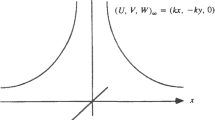Abstract
The elementary task is to calculate the growth rates of disturbances when the eN method in transition prediction is performed. However, there is no unified knowledge to determine the growth rates of disturbances in three-dimensional (3D) flows. In this paper, we study the relation among the wave parameters of the disturbance in boundary layers in which the imaginary parts of wave parameters are far smaller than the real parts. The generalized growth rate (GGR) in the direction of group velocity is introduced, and the conservation relation of GGR is strictly deduced in theory. This conservation relation manifests that the GGR only depends on the real parts of wave parameters instead of the imaginary parts. Numerical validations for GGR conservation are also provided in the cases of first/second modes and crossflow modes. The application of GGR to the eN method in 3D flows is discussed, and the puzzle of determining growth rates in 3D flows is clarified. A convenient method is also proposed to calculate growth rates of disturbances in 3D flows. Good agreement between this convenient method and existing methods is found except the condition that the angle between the group velocity direction and the x-direction is close to 90° which can be easily avoided in practical application.
Similar content being viewed by others
References
ARNAL, D. and CASALIS, G. Laminar-turbulent transition prediction in three-dimensional flows. Progress in Aerospace Sciences, 36(2), 173–191 (2000)
GASTER, M. A note on the relation between temporally-increasing and spatially-increasing disturbances in hydrodynamic stability. Journal of Fluid Mechanics, 14(2), 222–224 (1962)
GASTER, M. The role of spatially growing waves in the theory of hydrodynamic stability. Progress in Aerospace Sciences, 6, 251–271 (1965)
CEBECI, T. and STEWARTSON, K. On stability and transition in three-dimensional flows. AIAA Journal, 18(4), 398–405 (1980)
CEBECI, T., SHAO, J. P., CHEN, H. H., and CHANG, K. C. The preferred approach for calculating transition by stability theory. Proceeding of International Conference on Boundary and Interior Layers, ONERA, Toulouse (2004)
SU, C. H. and ZHOU, H. Physical implication of two problems in transition prediction of boundary layers based on linear stability theory. Science China Physics, Mechanics and Astronomy, 57(5), 950–962 (2014)
SU, C. H. and ZHOU, H. Stability analysis and transition prediction of hypersonic boundary layer over a blunt cone with small nose bluntness at zero angle of attack. Applied Mathematics and Mechanics (English Edition), 28(5), 563–572 (2007) https://doi.org/10.1007/s10483-007-0501-1
YU, G. T. and LUO, J. S. Application of eN method in three-dimensional hypersonic boundary layers (in Chinese). Journal of Aerospace Power, 29(9), 2047–2054 (2014)
MACK, L. M. Stability of three-dimensional boundary layers on swept wings at transonic speeds. Symposium Transsonicum III, Springer, Berlin/Heidelberg, 209–223 (1989)
MALIK, M. R. and BALAKUMAR, P. Instability and transition in three-dimensional supersonic boundary layers. The 4th Symposum on Multidisciplinary Analysis and Optimization, American Institute of Aeronautics and Astronautics, Reston (1992)
ZHAO, L., YU, G. T., and LUO, J. S. Extension of eN method to general three-dimensional boundary layers. Applied Mathematics and Mechanics (English Edition), 38(7), 1007–1018 (2017) https://doi.org/10.1007/s10483-017-2215-6
MALIK, M. R. COSAL-A Black Box Compressible Stability Analysis Code for Transition Prediction in Three-Dimensional Boundary Layers, NASA, CR-165952 (1982)
NAYFEH, A. H. and PADHYE, A. Relation between temporal and spatial stability in three-dimensional flows. AIAA Journal, 17(10), 1084–1090 (1979)
CHEN, X., ZHU, Y. D., and LEE, C. B. Interactions between second mode and low-frequency waves in a hypersonic boundary layer. Journal of Fluid Mechanics, 820, 693–735 (2017)
ZHAO, L. Study on Instability of Stationary Crossflow Vortices in Hypersonic Swept Blunt Plate Boundary Layer (in Chinese), Ph. D. dissertation, Tianjin University, 22–24 (2017)
ZHAO, L., ZHANG, C. B., LIU, J. X., and LUO, J. S. Improved algorithm for solving nonlinear parabolized stability equations. Chinese Physics B, 25(8), 084701 (2016)
KUEHL, J., PEREZ, E., and REED, H. JoKHeR: NPSE simulations of hypersonic crossflow instability. The 50th AIAA Aerospace Sciences Meeting including the New Horizons Forum and Aerospace Exposition, American Institute of Aeronautics and Astronautics, Reston (2012)
CHANG, C. L. LASTRAC. 3d: transition prediction in 3D boundary layers. The 34th AIAA Fluid Dynamics Conference and Exhibit, American Institute of Aeronautics and Astronautics, Reston (2004)
Acknowledgements
The authors are grateful to Ph. D. candidate Dongdong XU of Tianjin University for valuable discussion and suggestions.
Author information
Authors and Affiliations
Corresponding author
Additional information
Project supported by the National Natural Science Foundation of China (Nos. 11672351 and 11332007), the National Key R&D Plan (No. 2016YFA0401200), and the FengLei Youth Innovation Fund of China Aerodynamics Research and Development Center (No.KT-FLJJ-201803)
Rights and permissions
About this article
Cite this article
Song, R., Zhao, L. & Huang, Z. Conservation relation of generalized growth rate in boundary layers. Appl. Math. Mech.-Engl. Ed. 39, 1755–1768 (2018). https://doi.org/10.1007/s10483-018-2394-9
Received:
Revised:
Published:
Issue Date:
DOI: https://doi.org/10.1007/s10483-018-2394-9



